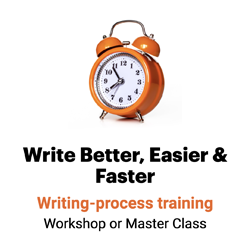3 steps to Writing Better, Easier & Faster
While we talk a lot about what to write — More stories! Fewer words! Shorter sentences! — we don’t focus so much on how.

Most of us were never taught to write. We were taught instead to rewrite: how to spell, punctuate and use the right grammar. As a result, we try to do three things at once: Figure out what to write, write it and get it right. No wonder writing is so hard!
But if you’ll break your work up into three stages of the writing process and write step by step, you’ll write better, easier and faster. This process has saved me thousands of hours of writing time over the course of my career.
Are you ready to write better, easier and faster? Here are the three writing process steps:
I. Pre writing
Pre writing is where you get ready to write, or develop a plan for your story. This step includes everything you do to prepare to put the first word onto the page:
A. Research. You’ve heard the phrase “hog in, sausage out.” That means that what you get out of the grinder will be no better than what you put in it.
That’s certainly true in writing. No matter how accomplished a writer you are, your story will be no better than your material. To research your message, conduct:
- Background research. Think of this as homework. This is all the research you do to get ready for the interview — from reviewing your subject-matter expert’s deck to asking Google to define cochlear implant. That will help you:
- Save time gathering information. Why reinvent the wheel?
- Prepare for the interview. (No more embarrassing questions!)
- Dig up juicy details that bring your story to life.
- Interview. When you nail down the basic facts in your background research, you can use the interview to add humanity and detail to the story. Instead of covering the five 5 W’s, you’ll spend your precious interview minutes getting anecdotes, analogies and compelling quotes. Think Terry Gross, not your high school journalism teacher.
- Observational research. You’ve heard of MBWA, or management by walking around? This is WBHA, or writing by hanging around — going to the scene to observe. Take a tour, watch a demo or see your subject in action. There’s nothing like being there to add compelling detail to your story.
B. Story angle. Like a tree, your message can branch out in different directions. But it should all come back to a single trunk. That trunk is your story angle.
Here’s a quick trick I use to come up with my story angle: Write your walkaway sentence — that’s the one sentence you want your readers to walk away with — in a single sentence, on the back of your business card. Use that sentence as your headline or deck, nut graph and wrap-up paragraph.
Then tape that business card to your monitor while you work. If a single paragraph, sentence or word doesn’t work to further that walkaway sentence, take it out.
C. Structure. Spend a few minutes organizing your message upfront, and you’ll save hours agonizing over it later
Put your effort up top. Most writers invest little time in the pre-writing process, focusing instead on fixing a lame draft during the rewriting phase.
Turn that investment upside down: Spend the bulk of your time getting ready to write, and you’ll spend less time fixing what you wrote. As a result, you’ll write better, easier and faster.
II. Free writing
There comes a point in any writing project where you have to follow Ernest Hemingway’s first rule for writers, and apply the seat of your pants to the seat of a chair. You have to write.
And that’s second stage of the writing process: free writing, or getting your rough draft on paper or the screen. It’s much easier to revise your work when you have a piece of writing to revise.
To free write your message:
- Get your nose out of your notebook. Typing up your notes isn’t writing; it’s typing. Moving your notes around in a Word document isn’t writing, either. The only way to write is to write. You know this stuff! Get your nose out of your notebook and write.
- Banish the grammar police. Use a dash instead of a semicolon? Write “you’re” when you mean “your”? Even misspell the CEO’s name? Don’t worry about it! You can always go back and fix your mistakes later. What you can’t do is go back and breathe life into a rough draft that never really got written in the first place.
- Write quickly, without stopping. In free writing, you want to achieve what creativity experts call “flow.” In that state, you’ll feel as if you can hardly type fast enough to keep up with your ideas — as if the words are flowing from your fingers. The only way to achieve that is to let momentum carry you along. So keep writing.
- Take a break and percolate. Stuck? Don’t just sit there. Do something! Get up. Move around. Get some fresh air. In a minute or two, you’ll find yourself back at your desk, eager to capture your next idea.
III. Rewriting
Here’s where you fine-tune your message: revising and editing and nailing grammar, spelling and punctuation.
This is what we used to call writing!
Spend enough time pre writing and free writing, and rewriting should be a breeze. Instead of heavy lifting — cutting and pasting and moving and fixing — rewriting becomes tweaking and polishing.
Why 3 stages of the writing process?
Writers who divide their writing into these steps are:
- Less likely to suffer from writer’s block
- More likely to meet their deadlines
- Unlikely to get stressed out in the process
Want to write better, easier and faster? Why not try pre writing, free writing and rewriting today?
___
Source: Richard Andersen, Writing That Works, McGraw-Hill, 1989

Leave a Reply